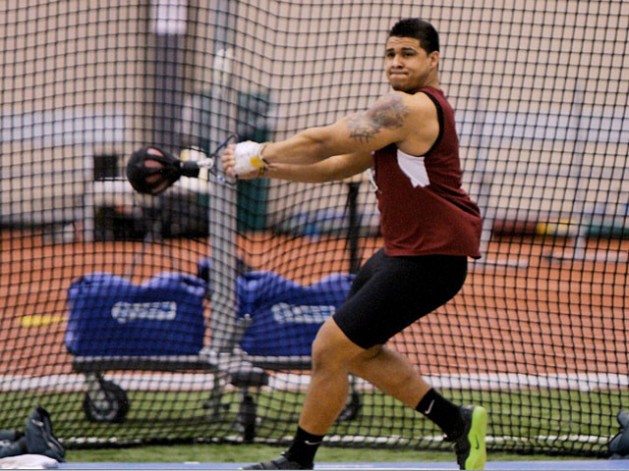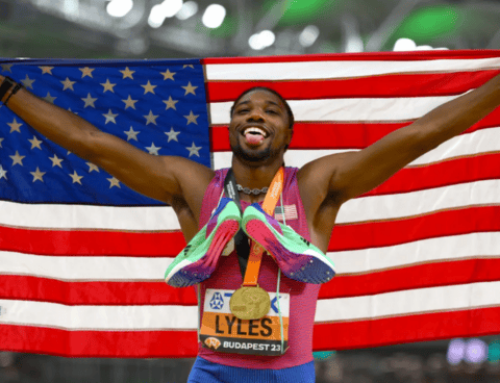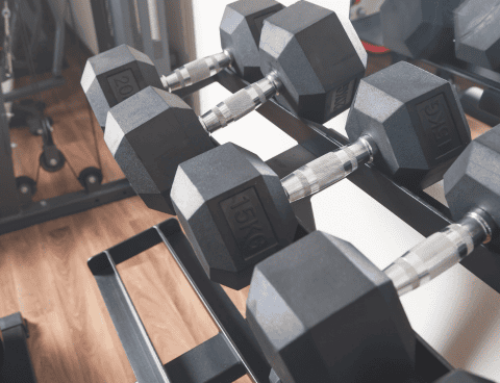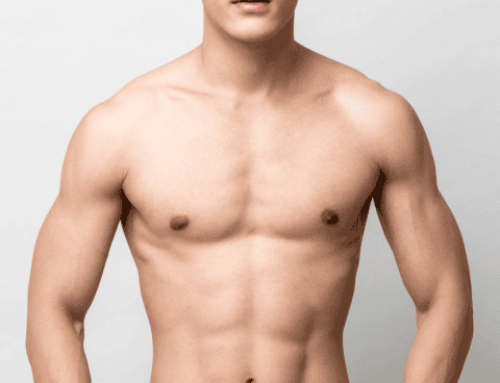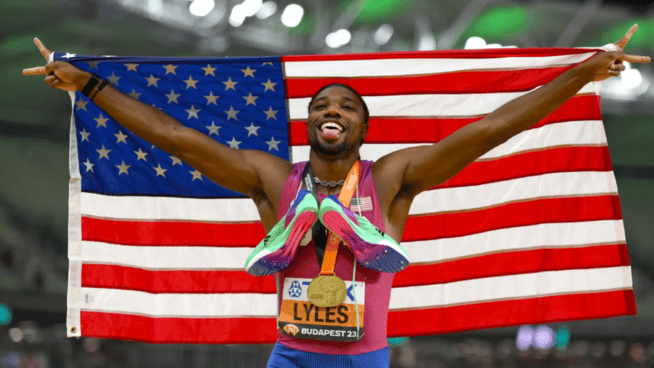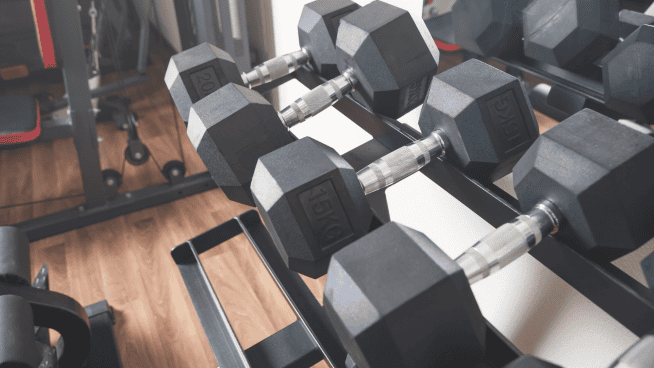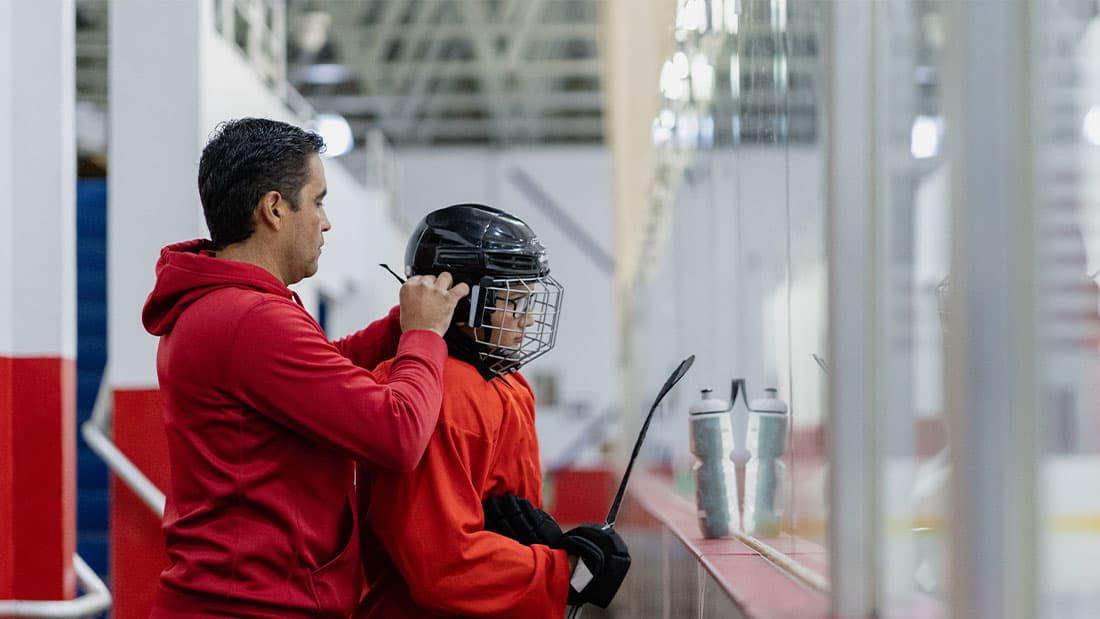5 Strength Exercises for Throwers
You’ve just finished a great session of throwing out at the rings, and you are very confident in your technique. However, since you are a dedicated athlete, you head straight to the weight room, ready to hammer away at the iron.
For throwers, this is a critical time to add distance to your throws by developing full-body strength, power and stability, allowing you to generate force from the ground and transfer it through your upper body to propel a long throw. Below is a list of five strength training exercises for throwers that will maximize your competitive results.
Power Snatch
Throwing is a full-body movement, so why not mimic that in the weight room? The Power Snatch is one of the best full-body movements you can perform to throw farther, because it generates tremendous force production in both the upper and lower body.
The exercise starts out with a triple extension of the ankles, knees and hips. The second phase is a powerful pull with the upper body. This builds the shoulders and traps, two muscle groups that are heavily engaged in every throwing event. The last part of lift is the catch. This increases stabilizer muscle strength to allow for a more complete transfer of force during the throw.
This exercise has many variations, but the best option for throwers is from the Hang, with pinky fingers positioned on the power ring. Set and rep ranges can vary a bit, but three sets of five reps at about 50 to 60 percent of your max will be effective. With such a light load, be sure to move the weight as quickly as possible to increase power on your throw.
Front Squat
Many people believe that throwing is predominately an upper-body sport, but they couldn’t be more wrong. World-class throwers also have enormous lower-body strength. The Front Squat is the most effective lower body exercise for building a better throw. In addition to working the quads, hamstrings and glutes, it engages the entire core to stabilize the body.
Be sure to rack the bar high up on your shoulders, very close to your neck. Grip the bar with the tips of your index and middle fingers to keep it in place, rather than resting the bar in your palms. This will stretch the forearms, a part of the body that can get very tight from throwing, especially in shot put. Keep your elbows up high, then break at the hips and sink down until your thighs are parallel to the ground. Make sure to remain upright with a slightly arched or neutral back and your chest out. On the way up, spread the floor with your feet to activate your glutes and hamstrings—two muscles often overlooked by throwers. Perform Front Squats for three to five sets of four to six reps at about 80 to 90 percent of your max.
Plate Twist
Core rotation is another important movement necessary for a thrower’s success. The ability to rotate quickly and separate the upper from the lower body as much as possible is critical for adding power to throws. The perfect exercise to develop this skill is the Plate Twist.
This is a fairly simple, but very effective exercise. Grab a plate of choice (ranging anywhere from 10 pounds to 45 pounds) with both hands. Extend your arms out in front and plant your feet on the floor with bent knees. Rotate your torso from side to side as quickly as possible, but under control. Perform three to five sets of eight to 15 reps. This develops strength and teaches your upper body and core to work together.
V-Ups
As mentioned before, the core is extremely important to throwing. If you can’t stabilize your entire core, your throwing effort could be useless. V-Ups are one of the best exercises to increase overall core strength and stability.
Lie flat with your back on the floor. Lift and extend your legs to a 35 to 45 degree angle from the floor and extend your arms until they are parallel to your legs. If you perform this correctly, your upper body will be off the floor. Repeat for three to five sets of 12 to 20 reps, and you’ll be on your way to having a bulletproof core.
Bench Press
Throwers are known for having big barrel chests. This is due to the massive weights they can lift on the bench. Having a strong Bench Press can put that little extra burst of power behind a throw to secure a victory. The Bench builds the chest, shoulders and triceps, all the muscles that help propel the final moment of your throw.
Grip the bar just outside shoulder-width. Unrack and slowly lower the bar to your sternum. Explosively drive the bar off your chest and spread the bar with your hands to activate your triceps and back. Repeat for three to five sets of three to eight reps at 80 to 90 percent of your max.
These are a few strength training exercises that throwers can do to help them become the best version of themselves. To really take your performance to the next level, the SPIRE Mac Wilkins Throws Academy offers a premier residential academy program designed specifically for throwers with aspirations to greatness in their sport. The Throws Academy cultivates strength, character, tolerance, solidarity and civility in each thrower within a highly specialized training and education environment.
Photo: VCSU.edu
RECOMMENDED FOR YOU
MOST POPULAR
5 Strength Exercises for Throwers
You’ve just finished a great session of throwing out at the rings, and you are very confident in your technique. However, since you are a dedicated athlete, you head straight to the weight room, ready to hammer away at the iron.
For throwers, this is a critical time to add distance to your throws by developing full-body strength, power and stability, allowing you to generate force from the ground and transfer it through your upper body to propel a long throw. Below is a list of five strength training exercises for throwers that will maximize your competitive results.
Power Snatch
Throwing is a full-body movement, so why not mimic that in the weight room? The Power Snatch is one of the best full-body movements you can perform to throw farther, because it generates tremendous force production in both the upper and lower body.
The exercise starts out with a triple extension of the ankles, knees and hips. The second phase is a powerful pull with the upper body. This builds the shoulders and traps, two muscle groups that are heavily engaged in every throwing event. The last part of lift is the catch. This increases stabilizer muscle strength to allow for a more complete transfer of force during the throw.
This exercise has many variations, but the best option for throwers is from the Hang, with pinky fingers positioned on the power ring. Set and rep ranges can vary a bit, but three sets of five reps at about 50 to 60 percent of your max will be effective. With such a light load, be sure to move the weight as quickly as possible to increase power on your throw.
Front Squat
Many people believe that throwing is predominately an upper-body sport, but they couldn’t be more wrong. World-class throwers also have enormous lower-body strength. The Front Squat is the most effective lower body exercise for building a better throw. In addition to working the quads, hamstrings and glutes, it engages the entire core to stabilize the body.
Be sure to rack the bar high up on your shoulders, very close to your neck. Grip the bar with the tips of your index and middle fingers to keep it in place, rather than resting the bar in your palms. This will stretch the forearms, a part of the body that can get very tight from throwing, especially in shot put. Keep your elbows up high, then break at the hips and sink down until your thighs are parallel to the ground. Make sure to remain upright with a slightly arched or neutral back and your chest out. On the way up, spread the floor with your feet to activate your glutes and hamstrings—two muscles often overlooked by throwers. Perform Front Squats for three to five sets of four to six reps at about 80 to 90 percent of your max.
Plate Twist
Core rotation is another important movement necessary for a thrower’s success. The ability to rotate quickly and separate the upper from the lower body as much as possible is critical for adding power to throws. The perfect exercise to develop this skill is the Plate Twist.
This is a fairly simple, but very effective exercise. Grab a plate of choice (ranging anywhere from 10 pounds to 45 pounds) with both hands. Extend your arms out in front and plant your feet on the floor with bent knees. Rotate your torso from side to side as quickly as possible, but under control. Perform three to five sets of eight to 15 reps. This develops strength and teaches your upper body and core to work together.
V-Ups
As mentioned before, the core is extremely important to throwing. If you can’t stabilize your entire core, your throwing effort could be useless. V-Ups are one of the best exercises to increase overall core strength and stability.
Lie flat with your back on the floor. Lift and extend your legs to a 35 to 45 degree angle from the floor and extend your arms until they are parallel to your legs. If you perform this correctly, your upper body will be off the floor. Repeat for three to five sets of 12 to 20 reps, and you’ll be on your way to having a bulletproof core.
Bench Press
Throwers are known for having big barrel chests. This is due to the massive weights they can lift on the bench. Having a strong Bench Press can put that little extra burst of power behind a throw to secure a victory. The Bench builds the chest, shoulders and triceps, all the muscles that help propel the final moment of your throw.
Grip the bar just outside shoulder-width. Unrack and slowly lower the bar to your sternum. Explosively drive the bar off your chest and spread the bar with your hands to activate your triceps and back. Repeat for three to five sets of three to eight reps at 80 to 90 percent of your max.
These are a few strength training exercises that throwers can do to help them become the best version of themselves. To really take your performance to the next level, the SPIRE Mac Wilkins Throws Academy offers a premier residential academy program designed specifically for throwers with aspirations to greatness in their sport. The Throws Academy cultivates strength, character, tolerance, solidarity and civility in each thrower within a highly specialized training and education environment.
Photo: VCSU.edu

